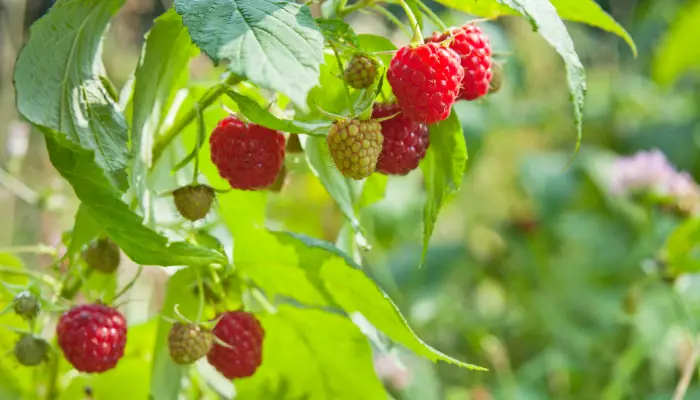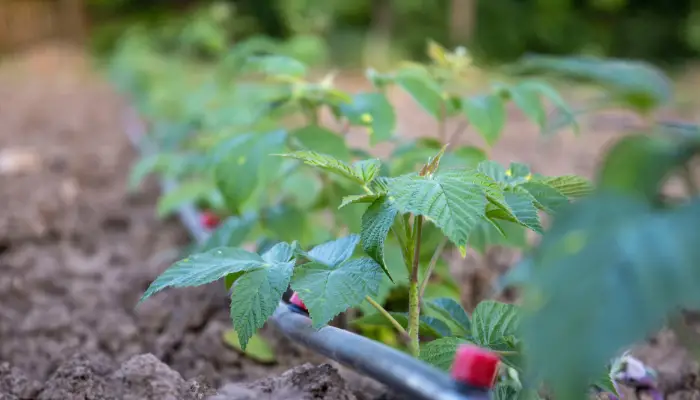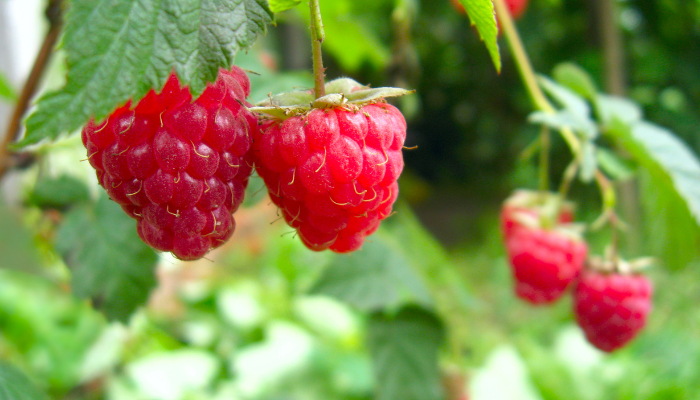How To Care For Raspberry Plants
Caring for raspberry plants is not very difficult, but it does require some attention and maintenance. Here are some tips on how to grow healthy and delicious raspberries in your garden.
Choose The Right Variety

There are many varieties of raspberries, but they can be divided into two main types: summer-fruiting and autumn-fruiting. Summer-fruiting raspberries produce one crop of berries in June or July, while autumn-fruiting raspberries produce two crops, one in late summer and one in autumn. Summer-fruiting raspberries need to be pruned and trained on wires or trellises, while autumn-fruiting raspberries can be grown as free-standing canes. Depending on your climate and preferences, you can choose the variety that suits you best. Some popular summer-fruiting raspberries are Glen Ample, Malling Jewel, and Tulameen. Some popular autumn-fruiting raspberries are Autumn Bliss, Joan J., and Polka.
Prepare The Soil
Raspberries need full sun for the best berry production. They should be planted in rich, slightly acidic (pH 6.0–6.5), well-drained soil that has been generously supplemented with compost and well-rotted manure. Raspberry plants must not be allowed to dry out during their flowering and fruiting seasons. You can also add some organic mulch, such as straw or wood chips, to help retain moisture and suppress weeds.
Plant The Canes
You can buy raspberry canes from nurseries or online suppliers, or you can propagate your own from suckers or root cuttings. The best time to plant raspberries is in early spring, before the buds break. Dig a hole about 15 cm deep and 45 cm wide for each cane, and space them about 45 cm apart in rows that are 1.5 m apart. If you are planting summer-fruiting raspberries, you will need to provide some support, such as wires or posts, to tie the canes to. If you are planting autumn-fruiting raspberries, you can leave them to grow naturally. After planting, water the canes well and cut them back to about 25 cm above the ground.
Prune The Canes
Pruning is an important part of raspberry plant care, as it helps to improve the yield and quality of the berries, and to prevent diseases and pests. The pruning method depends on the type of raspberries you are growing. For summer-fruiting raspberries, you need to prune twice a year: once in late winter or early spring, and once after harvesting. In late winter or early spring, cut out any dead, diseased, or damaged canes, and leave about six to eight healthy canes per plant. Tie these canes to the wires or posts, and cut off any side shoots that are longer than 20 cm. After harvesting, cut off the old canes that have fruited, and leave the new canes that have grown that year. These new canes will produce the next year’s crop. For autumn-fruiting raspberries, you only need to prune once a year, in late winter or early spring. Cut back all the canes to ground level, and new canes will grow from the base in spring. These new canes will produce the same year’s crop.
Common Pests and Diseases That Affect Raspberries?
Raspberries are delicious fruits that can be grown in your garden, but they also face some challenges from pests and diseases. Some of the common pests that can damage your raspberries are:
- Raspberry beetles: These are small, brown insects that lay eggs on the flowers and fruits. The larvae feed on the fruits and cause them to rot or become discolored. You can use traps or organic insecticides to control them.
- Spider mites: These are tiny, spider-like creatures that suck the sap from the leaves and cause them to turn yellow or bronze. You can use predatory mites or miticides to control them.
- Aphids: These are small, soft-bodied insects that also suck the sap from the leaves and stems. They can transmit viruses and cause curling or distortion of the leaves. You can use ladybugs or insecticidal soap to control them.
Some of the common diseases that can affect your raspberries are:
- Anthracnose: This is a fungal disease that causes purple or brown spots on the canes and leaves. It can reduce the vigor and yield of the plants. You can prune and dispose of the infected canes and use fungicides to control it.
- Botrytis or gray mold: This is another fungal disease that causes gray, fuzzy growth on the fruits and flowers. It can cause the fruits to rot or become moldy. You can reduce the humidity and improve the air circulation around the plants and use fungicides to control it.
- Raspberry mosaic disease: This is a viral disease that causes yellowing, mottling, or streaking of the leaves. It can reduce the size and quality of the fruits. There is no cure for this disease, so you should remove and destroy the infected plants and use virus-free plants for propagation.
How to Prevent Pests and Diseases in Raspberries?
There are some general measures you can take to prevent pests and diseases in raspberries, such as:
- Choose resistant varieties of raspberries that are suitable for your climate and soil conditions.
- Plant your raspberries in a sunny, well-ventilated, and well-drained location with plenty of organic matter and mulch.
- Water your raspberries regularly, but avoid overwatering or splashing water on the leaves and fruits.
- Prune your raspberries properly and regularly to remove any dead, diseased, or damaged canes and to improve air circulation and light penetration.
- Clean and sanitize your tools and equipment before and after using them on your raspberries.
- Monitor your raspberries for any signs of pests or diseases and act quickly to control them before they spread or cause more damage.
- Use organic or biological methods of pest and disease control whenever possible, such as traps, predators, beneficial insects, or natural remedies.
- Avoid using chemical pesticides or fungicides unless necessary, and follow the instructions and precautions carefully.
What is the Best Way to Water Raspberries?

Raspberries need consistent watering, especially during the growing season, but they do not like wet feet. The best way to water raspberries is to use a soaker hose or a drip irrigation system that delivers water slowly and deeply to the base of the plants. You should avoid watering from above, as this can cause rot and diseases. You should water your raspberries in the early morning, and give them about 1 to 1.5 inches of water per week from flowering to the end of fruiting. You can also use mulch to help retain moisture and prevent weeds. For more details, you can check out these sources. I hope this helps you grow healthy and delicious raspberries.
What is the Best Way to Fertilize Raspberries?
Raspberries are hungry plants that need regular fertilization to produce a good harvest. The best way to fertilize raspberries is to use a balanced fertilizer that contains equal amounts of nitrogen, phosphorus, and potassium (NPK). A balanced fertilizer will have the same numbers for these three nutrients, such as 10-10-10 or 20-20-20. You can use either organic or synthetic fertilizers, as long as you follow the instructions and precautions carefully.
You should fertilize raspberries once a year in early spring, before new growth begins. Apply the fertilizer in a 2-foot band around the base of the plants, but avoid direct contact with the stems. If you are growing raspberries in pots, you will need to fertilize them more often, every two weeks from April to September, with a high potash fertilizer.
You can also enrich the soil with compost or well-rotted manure, which will provide organic matter and nutrients to the raspberries. Compost or manure can be added at the time of planting, or as a mulch in spring. Make sure the manure is well-rotted, otherwise it can burn the roots and harm the plants.
Harvest The Berries
You will know your berries are ripe enough to eat when they are full of color and easily detach from the stem. You can start sampling them daily until you get the right sweetness. Be sure to harvest your raspberries before the birds do! You can protect your crop by covering the plants with netting or growing them in a fruit cage. Raspberries are best eaten fresh, but you can also freeze them, make jam, or use them in pies, cakes, and other desserts.
Enjoy Your Raspberries
Raspberries are not only tasty, but also nutritious. They are high in vitamin C, antioxidants, and fiber, and low in calories. They can help boost your immune system, lower your blood pressure, and prevent infections. By following these simple steps, you can grow your raspberries and enjoy their benefits all year round.
Frequently Asked Questions About Raspberries
Q: How often should I water my raspberry plants?
A: You should water your raspberry plants regularly, but avoid overwatering or splashing water on the leaves and fruits. You should give them about 1 to 1.5 inches of water per week from flowering to the end of fruiting. You can also use mulch to help retain moisture and prevent weeds.
Q: How do I prune my raspberry plants?
A: Pruning your raspberry plants depends on the type of raspberries you are growing. For summer-fruiting raspberries, you need to prune twice a year: once in late winter or early spring, and once after harvesting. For autumn-fruiting raspberries, you only need to prune once a year, in late winter or early spring. You should cut out any dead, diseased, or damaged canes and leave about six to eight healthy canes per plant.
Q: What are some common pests and diseases that affect raspberries?
A: Raspberries can be affected by various pests and diseases, such as raspberry beetles, spider mites, aphids, anthracnose, botrytis, and raspberry mosaic disease. You can prevent or control them by choosing resistant varieties, planting in a sunny and well-drained location, watering properly, pruning regularly, monitoring for signs of problems, and using organic or biological methods of pest and disease control whenever possible.
Q: How do I harvest and store my raspberries?
You can harvest your raspberries when they are full of color and easily detach from the stem. You can start sampling them daily until you get the right sweetness. You should harvest your raspberries before the birds do, or protect your crop with netting or a fruit cage. Raspberries are best eaten fresh, but you can also freeze them, make jam, or use them in pies, cakes, and other desserts








